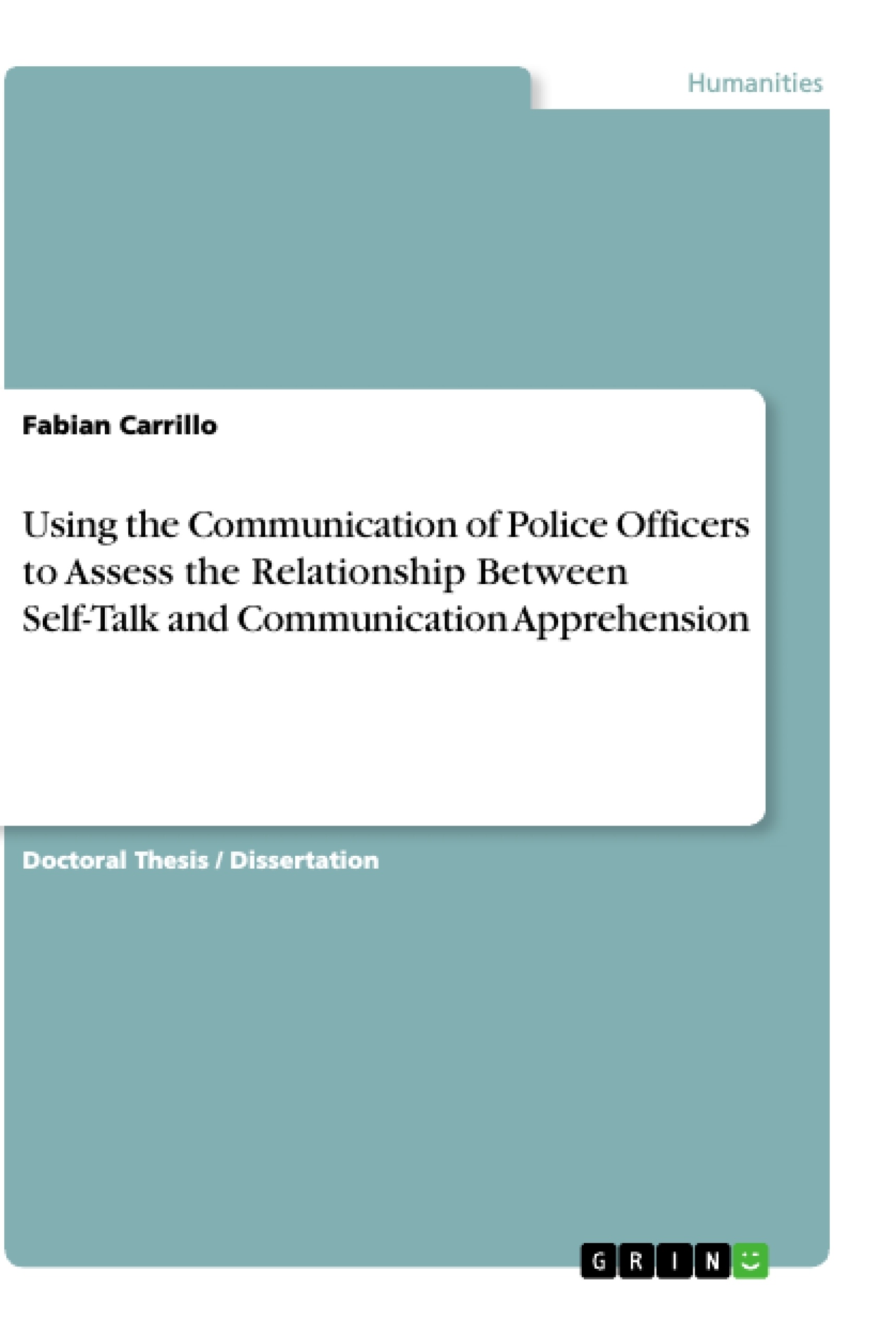The purpose of this research study was to assess the relationship between self-talk and communication apprehension among police officers within a western city police department (WCPD). Within the framework of the communication accommodation theory, the researcher expected that police officers would use self-talk to mitigate apprehension by adjusting their communication with the publics they engage with. Topics discussed within the literature review in respect to police officers include gaining public trust, public perceptions, team collaborations, facing stereotypes, mental illness, message diffusion, and social media. The researcher collected data from a convenience sample of 50 police officers from WCPD using the Personal Report of Communication Apprehension and the Self-Talk Scale. The results suggest that high self-talk usage is associated with low scores of communication apprehension and that high scores of self-talk usage are associated with high scores for the public speaking component of communication apprehension. These findings justify further research with larger samples, more representative of WCPD officers, whose results could serve as a basis for developing training for this population.
Inhaltsverzeichnis (Table of Contents)
- Chapter 1: Introduction
- Background
- Purpose of the Study
- Research Questions
- Significance of the Study
- Definitions
- Assumptions
- Limitations
- Chapter 2: Literature Review
- Communication Apprehension
- Self-Talk
- Communication Accommodation Theory
- Police Communication
- Chapter 3: Methodology
- Research Design
- Participants
- Instruments
- Data Collection Procedures
- Data Analysis
- Chapter 4: Results
- Descriptive Statistics
- Correlational Analysis
- Chapter 5: Discussion
- Summary of Findings
- Interpretation of Findings
- Implications for Practice
- Recommendations for Future Research
- References
- Appendix A: Institutional Review Board (IRB) Approval Letter
- Appendix B: Informed Consent Form
- Appendix C: Personal Report of Communication Apprehension (PRCA)
- Appendix D: Self-Talk Scale
Zielsetzung und Themenschwerpunkte (Objectives and Key Themes)
This quantitative correlational study aimed to investigate the relationship between self-talk and communication apprehension among police officers in a western city police department. The study sought to understand how police officers utilize self-talk to manage their apprehension in communication with the public. It was conducted within the framework of the communication accommodation theory, which posits that individuals adjust their communication based on the context and their perceptions of the other party.
- The relationship between self-talk and communication apprehension in police officers.
- The role of self-talk in mitigating communication apprehension in law enforcement settings.
- The application of communication accommodation theory to police-public interactions.
- The potential implications of the findings for training and development in police communication.
Zusammenfassung der Kapitel (Chapter Summaries)
- Chapter 1: Introduction - This chapter sets the stage for the study by providing background information on communication apprehension and self-talk, outlining the purpose and research questions, and highlighting the significance of the research. It also defines key terms, outlines assumptions, and acknowledges limitations of the study.
- Chapter 2: Literature Review - This chapter explores relevant literature on communication apprehension, self-talk, communication accommodation theory, and police communication. It provides a theoretical framework for the study and examines existing research findings related to the research questions.
- Chapter 3: Methodology - This chapter details the research design, participant selection, instruments used, data collection procedures, and data analysis methods employed in the study. It provides a comprehensive overview of the study's methodology.
- Chapter 4: Results - This chapter presents the findings of the study, including descriptive statistics and results from the correlational analysis. It provides a detailed analysis of the data and highlights key findings related to the research questions.
- Chapter 5: Discussion - This chapter interprets the findings of the study, discussing their implications for practice and future research. It summarizes the main findings, offers insights into their significance, and presents recommendations for future research directions.
Schlüsselwörter (Keywords)
The research focuses on communication apprehension, self-talk, police officers, public speaking, communication accommodation theory, and police-public interactions. The study explores the relationship between these concepts and provides insights into how police officers use self-talk to manage their communication apprehension.
- Citar trabajo
- Fabian Carrillo (Autor), 2020, Using the Communication of Police Officers to Assess the Relationship Between Self-Talk and Communication Apprehension, Múnich, GRIN Verlag, https://www.grin.com/document/902840



